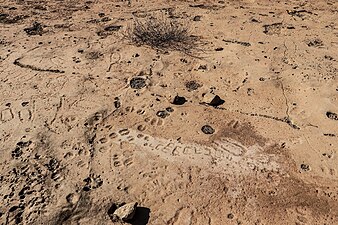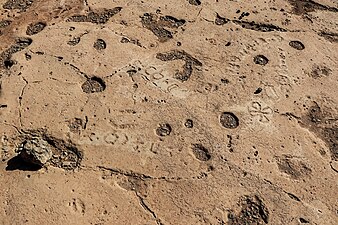Eriosh Petroglyphs
 Eriosh Petroglyphs: foot symbols | |
| Location | Socotra, Yemen |
|---|---|
| Coordinates | 12°35′38″ N, 53°49′8″ E |
The Eriosh Petroglyphs or Iryosh Petroglyphs or petroglyphs of Ariyūsh are a group of petroglyph carvings in the north-western coastal plain of Socotra island, Yemen. The group consists of pecked or carved graffiti, feet, geometric and crucial shapes, animals and anthropomorphs. The site is of unknown origin and age.[1][2]
Characteristics
The site is located about 20 km south-west of
The drawings depict feet, outlines of feet mostly in pairs, cloven hoof prints, crosses within circles or squares, and animals. The foot motifs are the most common symbol of the site. Many cruciform shapes are directly associated with foot motifs positioned either between or directly in front of them.[4] The graffiti may bear a resemblance to the characters of early South Arabian inscriptions of the mainland with Ethiopic characteristics.[5]
Although the site is the largest and best known petroglyph spot on Socotra, the chronological sequence is not clear as no full-scale archaeological survey or record of the entire site has been made so far. Some scholars have attributed the crosses to the Christian presence on Socotra, dating to sometime between the fourth and fifth centuries AD and relating them in part to those found on other archaeological spots of the island i.a. Hoq Cave and Suq.[2][5] Others suggest that these symbols may be a thousand years older.[6]
Gallery
-
Graffiti
-
Cloven hoof prints
-
Crosses
References
- ^ Nature and People in the Socotra Archipelago Retrieved 5 March 2023.
- ^ ISBN 978-0863721373.
- ISBN 978-0907151319.
- ^ Jansen van Rensburg, Julian (2018). "Rock Art of Soqotra, Yemen: A Forgotten Heritage Revisited". The Artist and Journal of Home Culture. 7: 99.
- ^ .
- ISBN 978-3-934106-91-8.



